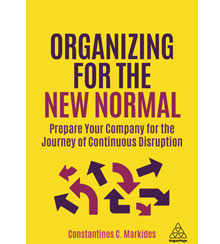Granting autonomy without losing control
In his new book, London Business School’s Constantinos C. Markides explains how leaders can ensure that employees know how to deliver on a company’s strategy.
A version of this article appeared in the Autumn 2021 issue of strategy+business.
A decentralized approach to management may become more prevalent in a post–COVID-19 world, and it is true that autonomy can be empowering in an organization. But it also has risks. When I asked the managing partner of a U.S.-based multinational brokerage firm how he makes sure that autonomy and initiative-taking in an organization do not end up in disaster, his reply was: “I give my people the canvas and the paint. It’s up to them to decide what they paint and how.” What he meant by this was that his people can have autonomy but within certain boundaries: Yes, they can paint whatever they want, but it has to be on our canvas, using only the paint that we give them. A similar analogy was given to me by the CEO of a French supermarket chain: “I tell my people where I want them to be and by what time. It is their decision how to get there.” Both responses suggest autonomy has to be within certain parameters or boundaries. When decisions have to be made, people will know if they have autonomy to make them or if they have to ask for permission or advice from their superiors.
I propose that there are two key parameters that an organization needs to put in place to guide decision-making. The first is the organization’s clearly communicated strategy. This is defined by the difficult choices leadership has made that determine which decisions are “strategic” (and should be undertaken only by top management) and which decisions are “operational” (and can be undertaken by employees). The second parameter is the organization’s values and purpose. As long as these are ingrained in the organization’s DNA, they will help employees decide what actions support the purpose and values and what actions do not support them. This, in turn, will help them decide what to do themselves and what to refer to top management to decide.
Parameter 1: Clearly communicating strategy
Decisions about strategy — such as deciding which customers to target or which products to sell — are the prerogative of top management and cannot be delegated to employees. You cannot have employees changing the product offering or the target customers without direct input from their leaders. Feedback from the market is obviously important and cannot be ignored. If this feedback is about the need to change or adjust the strategy, employees must report it to their superiors for them to decide whether to act. If the feedback is about operational issues, employees can respond to it autonomously. The principle is, therefore, simple enough: Employees can have autonomy to act on operational issues that improve what they’re already doing, but not on the choices that the organization has made that define its strategic direction.
Obviously, for employees to tell the difference between operational and strategic issues, they must first know what strategic choices the organization has made. This implies that the most important parameter that will guide employees’ behaviors — and the parameter that will permit autonomy without risking leadership losing control — is a clearly communicated strategy. By this, I mean the difficult choices the organization has made on three key issues: Who to target as customers and who not to target; what to offer these customers and what not to offer; and how to play the game relative to competitors — that is, what value chain activities to adopt and what not to adopt. This sounds simple enough, but there is overwhelming evidence that employees in most companies do not know the strategic choices their company has made. One academic study reported that even in high-performing companies with clearly articulated strategies, only 29 percent of employees knew what their company’s strategy was. This is not an isolated finding.
I believe there are three specific reasons for this lack of clarity in strategy: leaders’ failure to make choices in the first place, followed by failure to communicate clearly what eventually is chosen in the right way, and finally, dilution of those choices over time.
Make up your mind. The real problem that most organizations face is not whether they need to make three or four or five choices, but how to get their senior managers to make any choices at all. Failure to make choices leads to lack of clarity in strategy: Instead of being a clear statement of the (difficult) choices that the organization has made, strategy becomes nothing more than a vague and generic statement that lists all the wonderful things that the firm aims to achieve. This offers no guidance or direction to employees.
Assuming the firm has made explicit choices on the who, what, and how of the business, these choices need to be communicated to the entire organization. Often, this does not happen at all, or it is so ineffective that the strategy remains a mystery to the employees. However, even in the best-case scenario when the organization has made the choices required and top management has spent time and energy trying to communicate them in a clear and explicit way, the probability is still high that employees will fail to fully understand what is communicated because of a lack of specificity and information.
Be clear. Consider the following (real) strategy statement by a multinational: “Our strategy is to become a truly customer-led company and establish a platform from which to evolve and grow. We will drive innovation and value-adding integrated solutions and we will pivot to consultative customer partnerships and services business models.” Notice the mixing up of goals or aspirations with how these could be achieved, as well as the use of beautiful words that sound good but can mean different things to different people. Who really understands “value-adding integrated solutions” or “consultative customer partnerships”? Statements that can have multiple meanings create confusion and disagreements. To fully appreciate how serious this problem is, consider one of the most widely used phrases in business: “Think strategically.” I have asked hundreds of executives to tell me what comes to mind when they hear this. Among the most popular meanings are:
- Think long-term (at least three to five years into the future).
- Think about the big issues facing us (not the incremental ones).
- Start your thinking externally with the big changes and disruptions that are happening around us and then decide what to do internally.
- Do not panic; step back and think calmly about the changes around us.
- Think holistically about how the whole organization might be affected by what you want to do, not just your unit or division.
- Think about the issues collectively and cooperatively (rather than individually).
- Think about the big steps we need to be taking to achieve our vision.
These are just seven of the possible meanings of this phrase. Now ask yourself: “What happens in an organization when the same statement can have (at least) seven possible meanings?” Confusion.
In addition, simply communicating the choices you have made is often insufficient. What you really need to do is to communicate the choice and the alternatives considered and rejected in favor of the choice. It is the positioning of the choice relative to the alternatives considered that makes the choice clear to people. This means that what you need to say is not “We have decided to target customer X” but “We have decided to target customer X rather than customer Y or customer Z.” For example, choosing to be “the leading supplier in our markets” is not a credible choice. What alternatives to “leading supplier” have you considered and rejected?
The importance of communicating choices relative to the alternatives considered is an established concept in psychology. I realized its value early in my career when as head of my department at London Business School, I undertook customer research to decide what new courses to offer to our students. Specifically, all first-year MBA students were presented with a list of possible new courses and asked to indicate which ones they would want us to offer as electives in the second year of their MBA degree. Two courses proved to be particularly popular: a course on ethics, which 86 percent of students picked, and a course on sustainability, which 90 percent of students picked.
We spent the next few months developing the materials for these two new courses. Much to our surprise, fewer than 10 students (out of 400) chose to register for either of the two courses. In hindsight, the reason was obvious. The school’s portfolio of elective courses listed more than 80 from which students had to choose 15 for their second year. The students, therefore, had to make difficult choices. Instead of asking students, “Would you like us to offer you course A?” we should have been asking them, “If you had to choose between course A and course B, which one would you choose?” Only when alternatives are presented do real preferences become evident. The same goes for strategic choices.
Don’t dilute your choices over time. The choices made are always decided at a point in time, given the market realities that the organization is facing at that moment. Eventually, these market realities might change — new competitors may emerge, different customer needs may rise in significance, new technologies may enter the industry, and so on. Given the ever-changing nature of markets, an organization needs to be on constant alert, changing and adapting its original choices in order to respond to the changes happening around it. Here lies one of the biggest dangers to strategy: In the effort to respond to emerging threats or exploit new opportunities, an organization might slowly end up diluting its original choices and destroying its distinctive position in the market.
What is the solution to this problem? Surely the organization must respond to the changes happening around it, but how can it do so without weakening its strategy? One solution is to undertake only those responses (to the external changes) that fit its chosen strategy. An alternative is to accept that the responses will inevitably lead to a different strategy — accept this and, more important, communicate the changed strategy to your employees. There is nothing wrong with changing strategy; what is wrong is to change the strategy without acknowledging this, pretending that the old strategy is still valid.
Developing the correct strategy is not intellectually difficult, but it still requires strong leaders willing to make the difficult choices and willing to say no.
Parameter 2: Strong values and a motivating purpose
Not all purposes are motivating, and not all statements of organizational values are effective in guiding behaviors the way we have discussed here. To the contrary, if we judge by the fact that 87 percent of employees in the world claim to be disengaged or actively disengaged at work, the majority of purposes must be useless. The question that we must address, therefore, is, “What is the difference between motivating and non-motivating purposes, and what is the difference between values that guide behaviors and values that are ignored by people?” Despite a widespread belief that the words used or the content of the purpose and values statements is important, there is evidence to prove the opposite. Far more important is whether employees have “bought into” the purpose or statement of values. Are they truly energized by the purpose, and do they live by the values being promoted? Leaders need to find ways to actively “sell” these things to employees so as to win their buy-in. This, naturally, raises the question: “How can we sell our purpose and statement of values so that our people buy into them?” There’s a simple progression model to achieve this: I know; I understand; I think I will; I will.
Developing the correct strategy is not intellectually difficult, but it still requires strong leaders willing to make the difficult choices and willing to say no.
In the first stage, leaders need to communicate the purpose and values. Although this sounds simple enough, evidence suggests that people overestimate their ability to communicate clearly. For example, in an often cited experiment undertaken by Elizabeth Newton at Stanford in 1990, participants were asked to tap out a song to a group of listeners. The tappers were asked to guess what proportion of their listeners would identify the song they were tapping. On average, they expected 50 percent to get it; only 2.5 percent did, demonstrating people’s overconfidence in communicating clearly.
In the second stage, we need to explain the why: Why did we pick this particular purpose? At the end of this stage, you want people to say: “I know what you want me to do, and I understand why.”
The third stage is to create belief in what the purpose is. One tactic is to create and celebrate early victories. Another is to provide the necessary resources and the supporting environment to help achieve the purpose. Demonstrating through actions that the stated values not only are important but also take priority over financial results is probably the most effective way to create belief in them. If you succeed with this stage, your people will be saying: “I know what we need to do, I understand why, and I think we will do it.”
The fourth stage is by far the most difficult. This is when people go from rational acceptance to emotional commitment. For this, you need to make people feel special by making them feel unique — in other words, different from employees in other organizations. You must also make them feel that “we are in this together.” To achieve this, you have to foster a team spirit in which everybody is equal and interdependent. You can also use symbols and rituals to reinforce the team spirit.
How do you know if you have succeeded in selling your purpose and values to your employees to win their buy-in? The symptoms you should look out for are people who are full of energy and passion, having fun while working hard, enjoying the company of their colleagues, and never missing a chance to express how proud they feel to be members of the team. For them, coming to work is a joy because it allows them to pursue something they value, with people they trust, within an organization that shares their values and beliefs. It is only when this is achieved that you should be willing to give your people autonomy and freedom, comfortable in the thought that they will not do anything that will undermine the organization’s purpose or values.
The organization’s clear strategic choices and a motivating purpose along with strong values that employees have bought into are the key parameters that need to be put in place so that employees will know when to operate with autonomy and when to refer decisions to top management. Doing so will allow organizations to give autonomy to people without fear of losing control.
Author profile:
- Constantinos C. Markides is a professor of strategy and entrepreneurship at the London Business School and the author of numerous books. Organizing for the New Normal was published in April 2021.
- This article is adapted from Organizing for the New Normal© 2021 by Constantinos C. Markides, and is reproduced with permission from Kogan Page Ltd.





